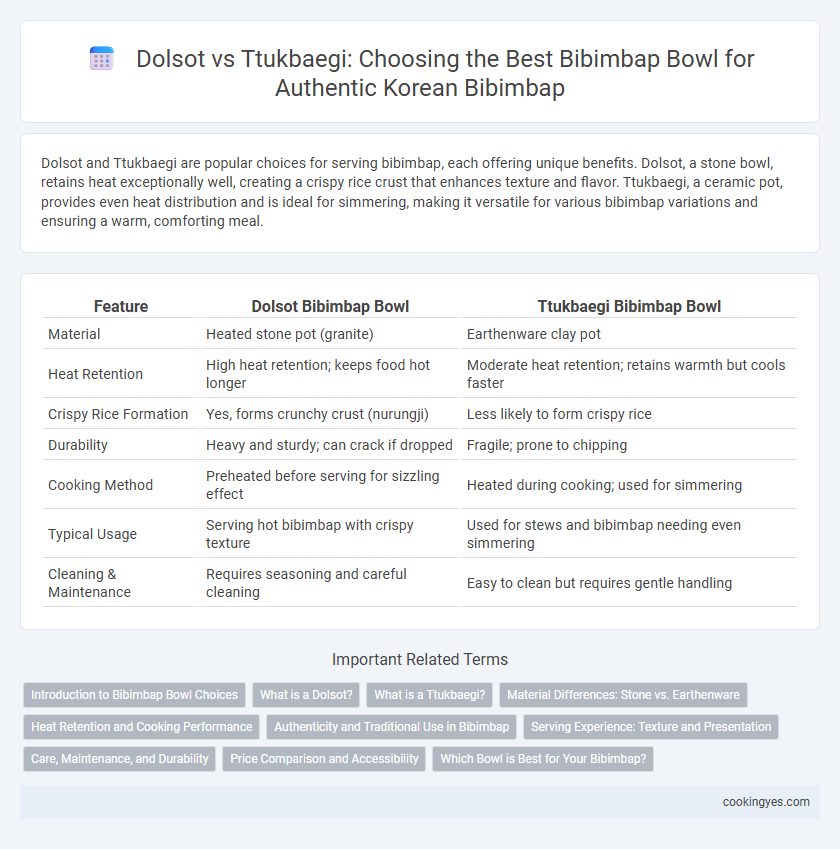Dolsot and Ttukbaegi are popular choices for serving bibimbap, each offering unique benefits. Dolsot, a stone bowl, retains heat exceptionally well, creating a crispy rice crust that enhances texture and flavor. Ttukbaegi, a ceramic pot, provides even heat distribution and is ideal for simmering, making it versatile for various bibimbap variations and ensuring a warm, comforting meal.
Table of Comparison
| Feature | Dolsot Bibimbap Bowl | Ttukbaegi Bibimbap Bowl |
|---|---|---|
| Material | Heated stone pot (granite) | Earthenware clay pot |
| Heat Retention | High heat retention; keeps food hot longer | Moderate heat retention; retains warmth but cools faster |
| Crispy Rice Formation | Yes, forms crunchy crust (nurungji) | Less likely to form crispy rice |
| Durability | Heavy and sturdy; can crack if dropped | Fragile; prone to chipping |
| Cooking Method | Preheated before serving for sizzling effect | Heated during cooking; used for simmering |
| Typical Usage | Serving hot bibimbap with crispy texture | Used for stews and bibimbap needing even simmering |
| Cleaning & Maintenance | Requires seasoning and careful cleaning | Easy to clean but requires gentle handling |
Introduction to Bibimbap Bowl Choices
Dolsot and Ttukbaegi are two popular choices for serving bibimbap, each enhancing the dish's texture and temperature differently. Dolsot, a heated stone bowl, creates a crispy rice crust called nurungji, adding a unique crunch and depth of flavor. Ttukbaegi, a ceramic earthenware pot, retains heat well to keep bibimbap warm but does not produce the characteristic crispiness of Dolsot.
What is a Dolsot?
A Dolsot is a traditional Korean stone bowl used specifically for serving hot bibimbap, known for its ability to retain heat and create a crispy rice crust called nurungji. Made from granite or other volcanic stones, the dolsot ensures even heat distribution, enhancing the flavors and textures of the dish. Compared to a ttukbaegi, which is a ceramic earthenware pot, the dolsot provides a unique sizzling experience that intensifies the taste and presentation of bibimbap.
What is a Ttukbaegi?
A Ttukbaegi is a traditional Korean earthenware pot commonly used for bibimbap, known for its thick walls that retain heat evenly and provide a slow cooking process. Unlike the heavier Dolsot, a granite stone bowl, the Ttukbaegi enhances broth-based dishes and offers a distinct earthy flavor, while still maintaining the rice's warmth and texture. Its versatility allows for both simmering ingredients and creating a crisp rice crust, essential for an authentic bibimbap experience.
Material Differences: Stone vs. Earthenware
Dolsot bibimbap bowls are crafted from stone, providing excellent heat retention that keeps the dish sizzling and creates a crispy layer of rice at the bottom. Ttukbaegi bowls, made from earthenware, offer a more porous texture that distributes heat more gently, resulting in a softer, evenly warmed meal. The choice between stone and earthenware significantly affects the texture and temperature experience of bibimbap.
Heat Retention and Cooking Performance
Dolsot bibimbap bowls, made from thick stone, offer superior heat retention, keeping the dish sizzling hot and allowing rice to develop a crispy crust known as nurungji. Ttukbaegi, constructed from earthenware clay, provides excellent heat distribution but cools down faster than dolsot, impacting the dish's texture and warmth. For optimal cooking performance and extended heat retention, dolsot remains the preferred choice in traditional bibimbap preparation.
Authenticity and Traditional Use in Bibimbap
Dolsot, a heated stone bowl, is cherished for its authentic role in traditional bibimbap, imparting a crispy rice crust called nurungji through direct heat retention. Ttukbaegi, a ceramic earthenware pot, is less common but valued in some regional bibimbap variants for its gentle heat distribution and subtle flavor enhancement. The choice between dolsot and ttukbaegi reflects cultural nuances in authenticity, with dolsot considered the quintessential vessel for the classic bibimbap experience.
Serving Experience: Texture and Presentation
Dolsot bibimbap bowls, made from stone, provide a sizzling, crispy texture as the rice forms a golden crust when served hot, enhancing the sensory experience and visual appeal. Ttukbaegi, a ceramic earthenware pot, retains heat evenly but lacks the crispiness, offering a softer texture throughout the dish. Presentation in dolsot bowls emphasizes the contrast between the crunchy rice and vibrant vegetables, while ttukbaegi highlights a steaming, hearty appearance with uniform warmth.
Care, Maintenance, and Durability
Dolsot bibimbap bowls, made from heavy stone, require careful seasoning and drying after each use to prevent cracking and mold growth, ensuring long-term durability. Ttukbaegi, constructed from sturdy earthenware with a glaze, demands gentle cleaning without abrasive materials to maintain its smooth finish and resist chipping over time. Both materials offer heat retention benefits, but proper care tailored to their composition extends their functional lifespan and preserves the authentic cooking experience.
Price Comparison and Accessibility
Dolsot bibimbap bowls typically cost between $20 to $40 due to their heavy, high-quality stone construction, making them a pricier option compared to Ttukbaegi bowls priced around $10 to $20. Ttukbaegi bowls are more widely accessible in everyday Korean households and local markets, whereas Dolsot bowls are often found in specialty stores or Korean restaurants. The affordability and availability of Ttukbaegi make it a practical choice for casual cooking, while Dolsot offers enhanced heat retention for a premium dining experience.
Which Bowl is Best for Your Bibimbap?
Dolsot, a sizzling hot stone bowl, retains heat longer and creates a crispy rice crust that enhances the texture and flavor of bibimbap. Ttukbaegi, a traditional Korean earthenware pot, retains heat well but distributes it more evenly, ideal for a softer rice texture without the crust. Choose Dolsot for a crunchy, bold experience and Ttukbaegi for a milder, evenly heated bibimbap.
Dolsot vs Ttukbaegi for bibimbap bowls Infographic

 cookingyes.com
cookingyes.com